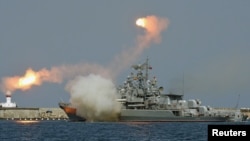With Monday’s signing of the Trans-Pacific Partnership [TPP], the United States reached a milestone in its push for rebalancing toward the Asia Pacific region.
A new hurdle may be emerging, however, and this time it is not China.
In the last few months, Russia has been steadily increasing its military presence in the Western Pacific region, threatening to complicate the U.S. strategy in the region.
Growing military presence
At a recent discussion at the Stimson Center in Washington, former Japanese Defense Minister Itsunori Onodera said Japan’s Self Defense Force has been scrambling more in the North against Russia air force incursions than in the South against Chinese forays over the Senkaku Islands, which are called Diaoyu Islands by Beijing.
The U.S. is a staunch ally of Japan, and is bound by treaty to defend the Asian nation against foreign aggression.
Admiral Harry Harris, Commander of the U.S. Pacific Command, told Congress last month that he was concerned about Russia’s growing military presence in the Pacific.
“Russia has a long coastline, and they have at least two major naval bases, including one for their ballistic missile submarines, two major air bases, and then a host of smaller operating bases in the Pacific,” the admiral said. “So, these are things that I worry about as I look at the panoply of threats that the United States faces in the Pacific.”
As part of the so-called "pivot" to Asia strategy, the U.S. Navy has pledged 60 percent of its warships for the region, which is believed by many observers to be intended to counter growing Chinese military power.
Slowing U.S. pace
Richard Weitz, a Russia expert at the Hudson Institute, a Washington-based research center, said Russia’s aggressive behavior in Ukraine last year, however, and its recent military actions in the Middle East, are slowing down the pace of the U.S. rebalance to Asia.
“The U.S. is concerned about Russian actions in the Pacific, but it is more concerned about Europe and the Middle East,” he said. “Therefore, flowing forces from those regions, as you would in the pivot to Asia, is not occurring as rapidly as it would if the Russians were not a threat in Europe and Middle East.”
Appearing together with Admiral Harris at the Congressional hearing last month, U.S. Assistant Secretary of Defense for Asia Pacific David Shear also expressed concerns about Russia’s growing military posture in the Asia Pacific region.
Shear said the Asia-Pacific Maritime Security Strategy, though, released in August by the Pentagon, deals not only with China’s aggressive behavior in the region, but also with Russia’s growing military activities in the western Pacific.









